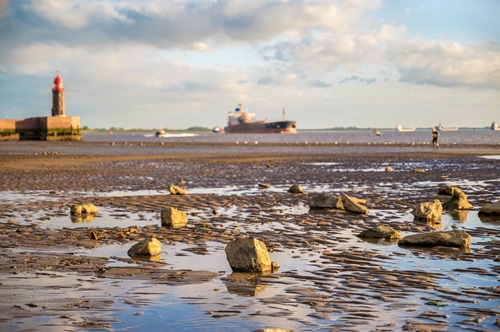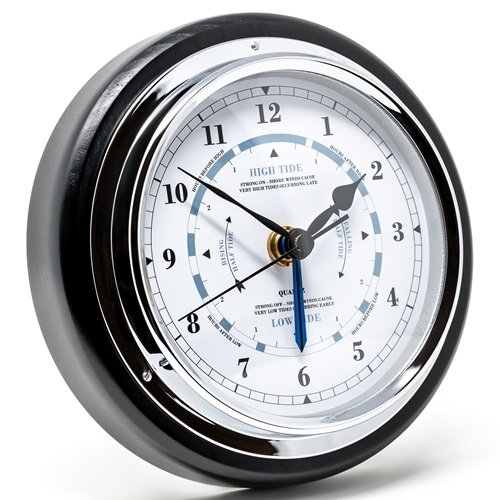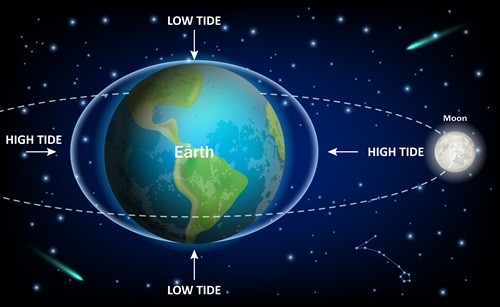Tides are periodic fluctuations in the sea level caused by the gravitational forces of the moon and the sun. The moon exerts the strongest gravitational pull on the earth, followed by the sun. Together they cause the water on the earth to rise and fall, creating the tides. The water level fluctuates between high water (high tide) and low water (low tide), the difference is known as the tidal range.
Origin and course of tides
Tides are caused by the gravitational forces of the moon and the sun as well as centrifugal forces. The gravitational force of the moon attracts the water on the moon's side of the earth more strongly than the earth itself, which leads to a rise in the water level (high tide). Due to the centrifugal force, a second tide is created on the opposite side of the Earth. Between these two tides is the low tide, where the water recedes. The sun also contributes to the tides, although its gravitational force is weaker than that of the moon. At full and new moon, the effects of the sun and moon add up (spring tide), at half moon they partially cancel each other out (neap tide).
The periodic rise and fall of the sea level occurs twice within 24 hours and 50 minutes. However, the effect of the tides is very complex and involves many factors that must be taken into account in order to accurately describe the tide at a particular location.
 The tides can be determined exactly from the astronomically effective forces. However, these do not correspond at all to the actual values of high and low tide on earth, neither in terms of height nor time. This is due to terrestrial effects caused by the shape of the basin and the depth of the seas, as well as the influence of the Earth's rotation on liquids.
The tides can be determined exactly from the astronomically effective forces. However, these do not correspond at all to the actual values of high and low tide on earth, neither in terms of height nor time. This is due to terrestrial effects caused by the shape of the basin and the depth of the seas, as well as the influence of the Earth's rotation on liquids.
The areas of greatest tidal range coincide almost without exception with shallow water areas with depths of up to 200 metres. On the islands in the ocean far from the coast, on the other hand, the theoretically calculated amounts are approached (53 cm lunar tidal range and 24 cm solar tidal range). The times at which the tides occur can be determined with a certain degree of reliability, but the tidal ranges depend on the stability of the orbits.
Tide clocks - an interplay of natural laws and expertise
Tide clocks, also known as tide gauges, take us into a world in which time is not determined exclusively by man-made mechanisms, but also by the forces of nature. These fascinating timepieces have a long history and are more than just instruments for measuring time, as they are in harmony with the tides.
 The origins of tide clocks can be traced back to Ancient Greece, where astronomers tried to record the movements of the tides with the help of mechanisms. Over the centuries, different cultures and civilisations have developed their own versions of tide clocks, but the basic idea has always remained the same: to use the movements of the tides as the basis for measuring time.
The origins of tide clocks can be traced back to Ancient Greece, where astronomers tried to record the movements of the tides with the help of mechanisms. Over the centuries, different cultures and civilisations have developed their own versions of tide clocks, but the basic idea has always remained the same: to use the movements of the tides as the basis for measuring time.
Some tide clocks use complex mechanisms to precisely record these movements and convert them into a time measurement. Other tide clocks, on the other hand, have a more minimalist design and use simple but effective methods to depict the tidal cycles.
The average time between two meridian passages of the moon is 24 hours, 50 minutes and 30 seconds. This is known as the lunar or tidal day. It means that the tidal day is 50 minutes longer than the solar day of 24 hours. In other words, the tide hand, which indicates the average tide, lags behind the regular time by 50 minutes every 24 hours.
Although tide clocks are no longer a primary method of measuring time, they still have a special place in the world of clocks. Many people appreciate the symbolic connection to nature and the uniqueness of these timepieces. Tide clocks are also popular decorative pieces, particularly in coastal areas, which create a link to maritime heritage.
Order nautical measuring instruments and other products from FISCHER
The FISCHER online shop offers you a high-quality selection of tide gauges. We also offer suitable measuring instruments for deep-sea navigation, water sports and outdoor leisure activities. You can order barometers and various watches for your adventures on the open sea. These precision mechanical instruments, which we manufacture ourselves in our factory, are characterised in particular by their precision. Do you have any questions about our products? Then please feel free to contact us. We are also happy to answer your questions about tide watches at any time.
Pictures: Ralph Geithe, Siberian Art






